2026 F1 regulations revealed: 'smaller, nimbler, raceable' rules explained
The FIA and F1 have revealed the world championship's new technical regulations for 2026 – we break down the new rules below
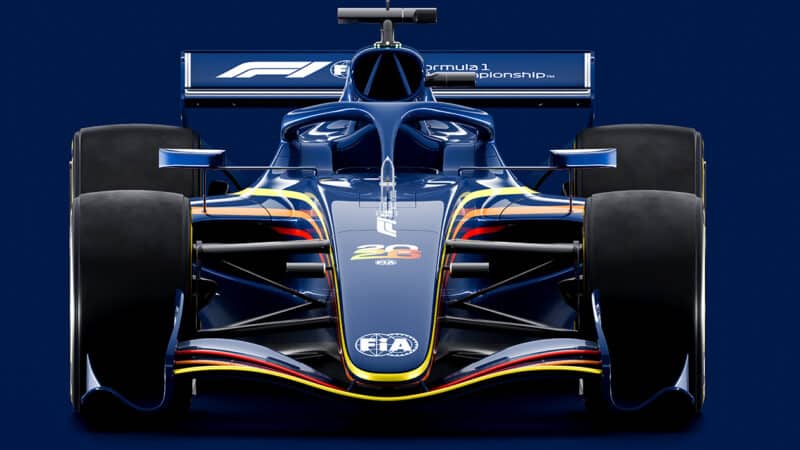
F1's 2026 technical regulations have now been finalised
The FIA governing body and Formula 1 have announced the new technical regulations for 2026, seeing some of the most profound changes in the history of the world championship, with the cars intended to be more “nimble and raceable”.
Active aerodynamics, an engine featuring 50% electrical power and narrower tyres all make up the new set of rules.
Rumours have flown about engines revving at maximum RPM mid-corner, cars spinning on the straights and down shifting at full speed – but now some degree of clarity has been given on the future technical direction of F1.
“A significant part of these regulations has involved thinking about the fans,” says FIA single seater technical director Nikolas Tombazi on release of the rules.
“We believe we made a step towards closer racing in 2022, but there were also things we got wrong and we’re trying to get it completely right now. We believe the racing will be much more exciting and much closer between cars.”
We provide a full breakdown on the 2026 F1 technical regulations below.
Chassis – 2026 F1 cars set to be smaller
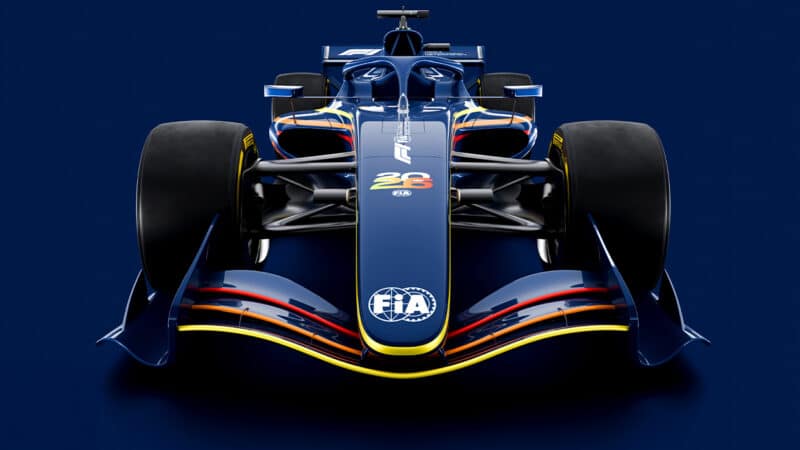
The F1 2026 chassis will be narrower
FIA
The present generation of F1 cars are some of the largest ever seen in grand prix racing.
F1 machines are currently a maximum 5.63m in length, 2m wide and 95cm tall.
However, all these numbers are set to be reduced with the 2026 regulations.
The cars will have a reduced wheelbase of 3.4m (shorter by 20cm), will be 10cm narrower, while the wheels will be narrower too – the front tyres will be reduced by 25mm and the rears 30mm.
“With this set of regulations the FIA has sought to develop a new generation of cars that are fully in touch with the DNA of Formula 1 – cars that are light, supremely fast and agile but which also remains at the cutting edge of technology, and to achieve this we worked towards what we called a ‘nimble car’ concept,” says Tombazi.
Weight – 2026 F1 cars set to be lighter
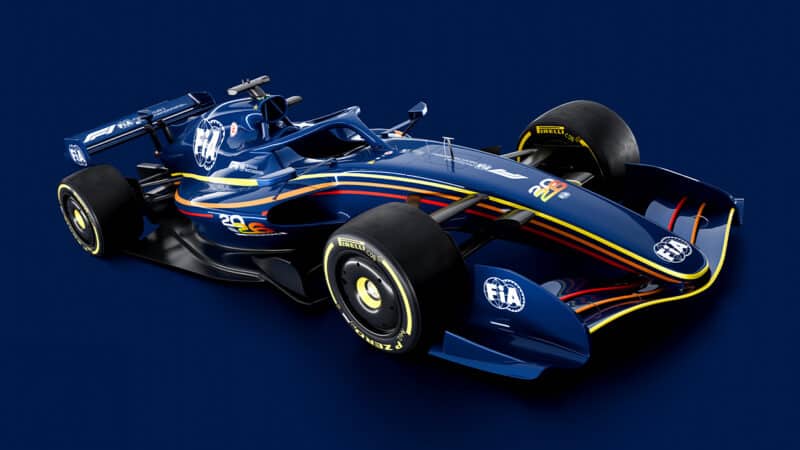
Cars set to be lighter in spite of increased battery size
FIA
Due to F1’s current supersized dimensions, the cars are also amongst the heaviest in the history of the world championship.
They currently weigh 800kg – and that’s before the driver is added.
The new rules – with the slightly smaller chassis dimensions prescribed above – mean the cars will become lighter, even with the heavier power units.
The car’s total weight will therefore be reduced to 768kg, a reduction of over 30kg.
“Lighter, more powerful and more focused on driver skill, the 2026 regulations have been designed to provide closer racing among drivers, increase the competition between teams and to improve the spectacle,” adds Tombazis.
“It was a key target of the new regs to hopefully reverse the ever increasing minimum weight of the cars over the last 20 years and make a step in a good direction by reducing the weight,” says Jan Monchaux, FIA single-seater technical director.
“We’ve done that primarily by moving to a smaller dimension. A smaller car in length and width is less material, so less weight. A simplification of the aero concept, so that some parts which currently are quite complex and quite heavy will be a lot simpler. And that will also come with some automatic weight reduction. We’ve got the tyres which will be 8% narrower, so also a weight saving there.”
Engine – 2026 F1 power units to be 50% electric, 50% internal combustion
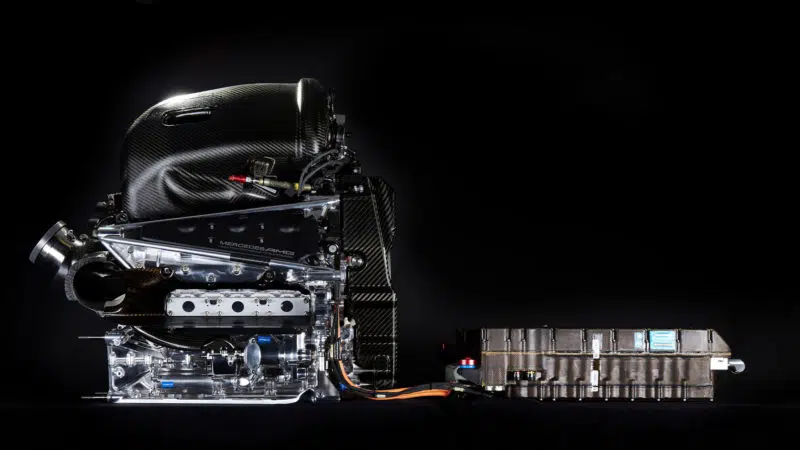
V6 power unit and battery were introduced to F1 in 2014 – the specification will radically change for 2026
Mercedes
F1’s engines are currently 1.6-litre V6 hybrid units. In addition to the combustion unit, power also comes from a kinetic energy recovery system (MGU-K) and a heat recovery system (MGU-H). The engine can produce up to 1000bhp, with the MGU-K contributing 130bhp-160bhp of the, the MGU-H and the combustion unit doing the rest.
However, for 2026 the MGU-H will be abandoned, largely due to its lack of relevance to road going cars, and the electrical unit contribution increased, meaning the new engine will be 50% ICU and 50% electric.
This means the ICU will produce 400kW (536bhp) and the MGU-K section will contribute around 350kW (469bhp). This increased electrical power will require a bigger battery, adding weight from this element of the car.
“The MGU-H was one of the most expensive and technologically complex elements of the current PU and we therefore decided to remove it from the 2026 regulations,” says Vincent Pereme, the FIA’s head of powertrain.
“So now the focus is on the electric engine. We will have a constraint on the maximum boost level [in the ICU], to 4.8 bar, when with the current PUs that was unlimited. This is to help any newcomers to avoid pursuing unreachable limits and to stay within a range they can manage.”
The electrical deployment will be limited as the cars head towards and hit 211mph on safety grounds, otherwise the cars would have the potential to hit 250mph on the straights.
However, teams will be allowed to use more power as an extra boost to overtake when following another car closely.
“A Manual Override mode has been included to created improved overtaking opportunities,” states the new rule specification. “While the deployment of a leading car will taper off after 290km/h [180mph], reaching zero at 355km/h [220mph], the following car will benefit from MGU-K Override providing 350kW [470bhp] up to 337km/h [209mph] and +0.5MJ of extra energy.
“Thanks to the much larger amount of electrical power available in ’26, drivers will be able to harvest a lot more energy in the braking phase and then use that energy for the next acceleration,” says Pereme.
“Additionally, a much bigger battery and more electrical power will mean the cleverest teams and drivers will be able to gain an advantage in using this electrical energy in the right part of the circuit.”
When set to maximum output, it’s thought the engine will match the current regulations in producing something in the region of just over 1000bhp.
Similar to now, teams will be limited to using three engines per season.
2026 F1 aerodynamic regulations: Active aero to be added to Drag Reduction System
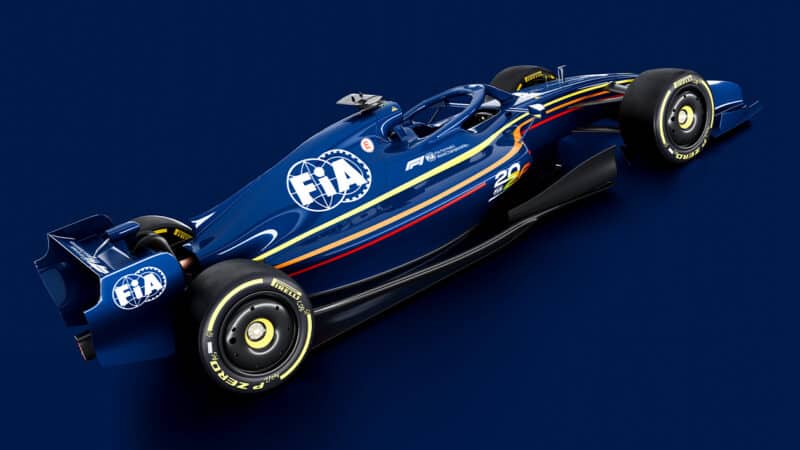
Rear and front wings will feature active aero
FIA
The Drag Reduction System will be replaced from 2026 onwards, replaced by an ‘Active Aerodynamics’ system.
Though not as wide-ranging as first thought, the new rules will include another three-element movable on the rear wing when the car is running at speed on the straights.
In addition to this will be a section on the front wing with two active elements, similarly in use when the car is in a ‘low-drag mode’ on the straights. In corners the non-deployment is termed ‘Z-mode’ and the use of low-drag active aero on straights in labelled ‘X-mode’.
“Typically, DRS is an overtaking aid and you grant DRS when you’re within one second of a lead car at specific points,” explains FIA head of aerodynamics Jason Summerville.
“With the 2026 car we’ll be giving the drivers the ability to switch between the high downforce and low drag modes irrespective of any gaps. So at pre-defined points around the lap, a driver will be able to switch to a low-drag mode to give them the performance down the straights where they’re not grip limited.
“Then, as you approach the braking zone, you’ll switch back to your high downforce mode. Each car would have the ability to switch between these two modes, entailing moving the rear wing and readjusting the front wing, and any following car would do the same.”
Teams will neither be allowed to operate the active aero through corners nor either wing independently of one another.
The front wheel arches will also be removed from 2026 onwards, and the cars will also have a partially flat floor with a reduced ground-effect element – as well as a spec ‘control-board’ to control wake generated from the front wheels.
Overall, downforce will be 30% lower and drag 55%.
There was speculation that with the new aerodynamic arrangement cars would have to run at F2 speeds through corners due to nervousness at the rear end – though this has since been dismissed, it’s thought the 2026 generation of machines will be trickier to driver, particularly with oversteer on corner exits.
“One of the main changes for 2026 aerodynamically hinges on reducing the drag from the rear wing,” says Jason Summerville.
“In order to reduce the overall drag, we have an active portion of the rear wing, akin to the DRS system that we currently have, although with more moving elements, which move to a greater degree.
“From our simulation work with the teams and their drivers, as soon as you have a rear wing that moves to reach the target drag level, it was clear that you needed to have an active front wing to match the balance characteristics.
“There were certain conditions where the drivers didn’t feel comfortable with a large forward aero balance, meaning lots of downforce on the front and not much downforce on the rear. So that led us towards the need to have an active front wing, as well as an active rear wing.”
“We expect cars to be still very challenging to drive, there will be a bit less downforce on the cars, there will be a few more things to look after for the drivers,” adds Tombazis.
“And hopefully, together with the closer racing, [it] will always keep it a drivers’ championship and a big challenge for these very intelligent and talented individuals.”
F1 2026 tyres set to stay at 18in – with one difference
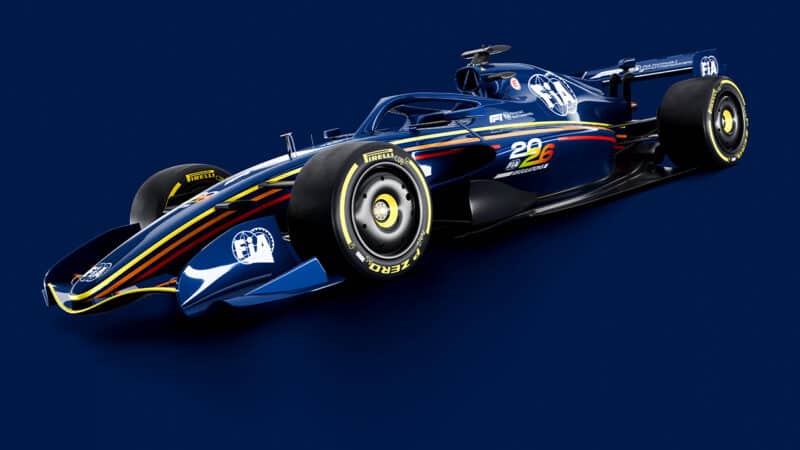
Wheels will stay similar diameter, but will be narrowed
FIA
Pirelli will continue to supply F1 tyres from 2026 onwards, with some alterations being made to the specifications on sustainability and efficiency grounds.
Though the wheel will remain 18 inches in diameter, the width will reduce an unspecified amount.
“The first idea was to go to 16in to save weight [but] the first size proposed was a bit too small,” said Pirelli motor sport boss Mario Isola recently.
“So we made a proposal to design a ‘smaller’ 18-inch tyre, so we can save some weight.
“After looking at the simulations that we got from the teams, aerodynamic loads in 2026 will be a bit lower compared to now.
“But you know how good the teams are at developing – we cannot rely on that number. So we believe our proposal’s a good compromise between weight and the load capacity of the tire.”
The FIA has now revealed that front tyres will be 25mm narrower and the rears 30mm.
On-track testing of the new tyre will begin on a mule car in September this year.
F1 2026 fuel – world championship aims for 100% renewable fuel

F1 plans to move to 200% renewable fuel
Getty Images
F1 plans to use 100% sustainable fuels from 2026. Produced by ARAMCO, the “lab-created” blend will apparently be a combination of carbon-capture, food waste and refuse.
With further aims of efficiency, the amount of fuel used in F1 races is targeted to reduce.
Three years ago cars used 100kg of fuel over a grand prix, but the aim is for this to be 70kg when the electric engine unit and increased efficiency is taken into account.
